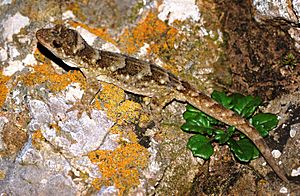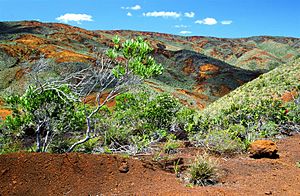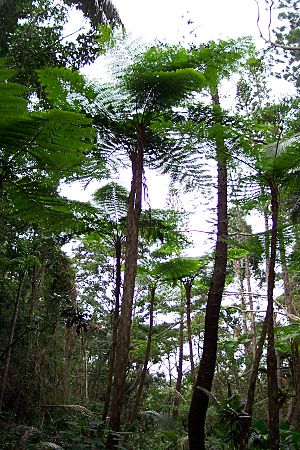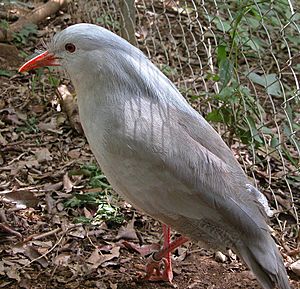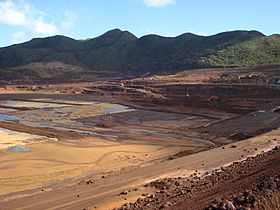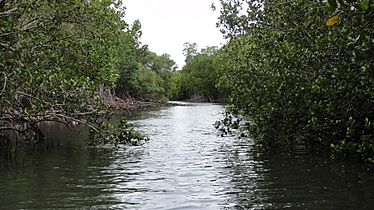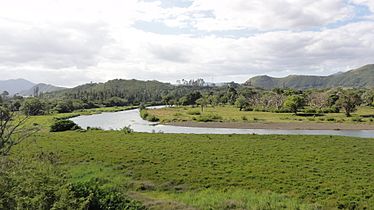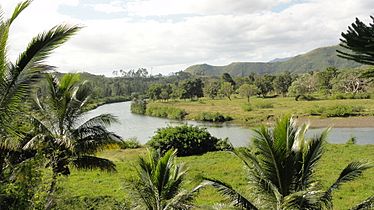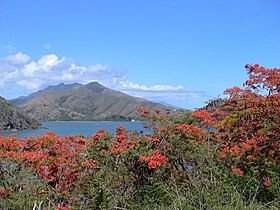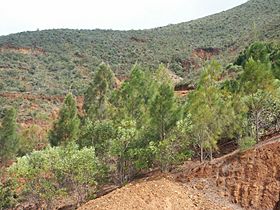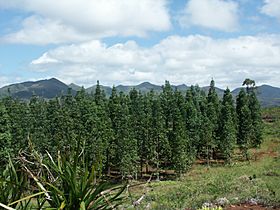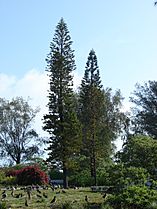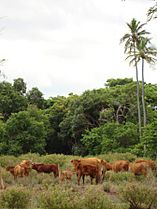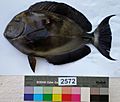Biodiversity of New Caledonia facts for kids
New Caledonia is a group of islands in the South Pacific Ocean. It's known for its amazing variety of plants and animals, many of which are found nowhere else on Earth! This makes it a "biodiversity hotspot." The islands cover more than 18,000 square kilometers. They have many different types of land, like coral reefs, small islands, and mountains. This mix of environments helps lots of different species live there. The weather is warm and tropical.
New Caledonia is very far from any large landmass, over 1,000 kilometers from the nearest continent. This isolation has lasted for millions of years. Because of this, many ancient species have survived here, and new unique species have developed over time.
Contents
Where is New Caledonia?
New Caledonia is located at the southern edge of the tropical zone, close to the Tropic of Capricorn. It's part of a region called Melanesia. The main island is called Grande Terre. Other parts include the Loyalty Islands, the Belep archipelago, the Isle of Pines, and the Chesterfield Islands.
These islands are about 1,300 kilometers east of Australia. They are also about 1,500 kilometers from New Zealand and 1,200 kilometers from Fiji. There are no easy "island-hopping" paths for animals to travel to or from bigger continents. However, some plants, insects, sea animals, and many flying creatures like birds and bats have managed to reach New Caledonia. They might have flown there, been carried by storms, or even by ocean currents. Humans have also brought some species.
Some plants and animals from New Caledonia have also spread to other Pacific islands. For example, the New Caledonian parakeet is the ancestor of many parakeet species found on other islands. Birds that eat fruit, like doves and toucans, help spread seeds by eating them and then dropping them in their waste. This is a big way seeds travel across oceans. Small things like grass seeds, algae spores, and even snail eggs can stick to birds' feet or feathers and travel long distances.
Grande Terre, the main island, has many different types of habitats. These depend on the amount of rain, the type of rocks, the soil, and how high up the land is. New Caledonia has thick evergreen forests, shrublands, dry forests, wetlands, savannas, and salty plant areas. The island has two main natural areas: the eastern part has the New Caledonia rainforests, while the west coast has the New Caledonia dry forests, which are now much smaller.
The ocean around New Caledonia is famous for its large coral reefs.
It's amazing how much biodiversity is packed into such a small land area in New Caledonia. This is partly because of the different types of soil and land, which create many unique environments.
How New Caledonia Was Formed
New Caledonia is made of pieces of an ancient supercontinent called Gondwana, which existed over 100 million years ago. It also has volcanic rocks. These pieces broke off from the Indo-Australian tectonic plate. Many scientists believe New Caledonia is part of a sunken continent called Zealandia. Zealandia separated from Australia about 80-90 million years ago. This means New Caledonia has been isolated for tens of millions of years, possibly since the Cretaceous period.
However, newer ideas suggest that the island as we see it today formed more recently, about 30 million years ago. This happened as different pieces of oceanic islands and underwater mountains came together. This idea helps explain the types of plants and animals found there today.
Long ago, during the Carboniferous and Permian periods, New Zealand and New Caledonia were at the edge of Gondwana, near the South Pole. As Gondwana moved north, the climate became warmer.
New Caledonia separated from Australia about 66 million years ago and from New Zealand in the middle Miocene period. This process was very slow and complicated, and scientists are still learning about it.
The soil on the islands comes mostly from special rocks called ultramafic rocks. These soils are often acidic and have unusual amounts of nutrients, like too much magnesium and high levels of heavy metals like nickel. Many native plants have adapted to these tough conditions over a long time. This makes it hard for new, invading plant species to grow there.
Because of these unique soils, many native plants are "extremophiles," meaning they can live in environments that are toxic to most other plants. This gives them an advantage over plants that try to invade. Ultramafic rocks also have high amounts of chromium and nickel, which can be harmful to plants. This leads to special types of plants growing in these areas, like the "wet maquis" shrublands in the New Caledonia rainforests. These plants are often small and unique to the area.
Ancient Life on the Islands
The ancient sea animals around New Caledonia were unique to that area. When Gondwana started to break apart, we can see new types of sea creatures in the fossils. During the Cretaceous period, flowering plants like Nothofagus and Proteaceae arrived in New Zealand and New Caledonia from South America, traveling along the edge of Antarctica.
When the Tertiary period began, New Zealand and New Caledonia moved north into a warmer climate. This started a very long time of evolution where species developed in almost complete isolation. New Caledonia has species whose ancestors were there when the island broke away from Gondwana. Some entire groups of plants and animals are found only on these islands.
How Life Changed Over Time
The plants and animals of New Caledonia are like living relics of a type of forest that once covered much of the Earth's tropical areas. This included parts of Australia, South America, Antarctica, and North America. Even though these forests disappeared during ice ages, they came back when the climate was good again. At other times, they were replaced by plants that could handle cold or dry weather. Many species died out because they couldn't cross new oceans, mountains, or deserts. But some found safe places in coastal areas and on islands.
As large landmasses became drier and harsher, these forests shrank to only certain areas. Even though some ancient, rich plant life remained in sheltered spots, their variety decreased. New Caledonia's location in the Pacific Ocean helped keep its climate mild and humid. This allowed these ancient plant communities to survive until today.
Many of these species need a "laurel forest" environment, which is moist and mild. They are strong plants that can easily grow in suitable habitats. The islands' isolation and special soil conditions also helped protect them. Some plants, like Sebertia acuminata, are even special because they can collect large amounts of nickel from the soil.
Some scientists used to think that New Caledonia might have sunk underwater at different times as it moved north, killing off all its land plants and animals. But plant experts argue that some areas must have stayed above sea level, acting as safe havens. Many plants from the ancient Gondwana continent survived in New Caledonia's steady climate. They died out in Australia because it became too dry. New Caledonia wasn't completely cut off, though. Sea levels changed during ice ages, creating land bridges or islands between New Caledonia and its neighbors like the Solomon Islands, Vanuatu, and Australia. This allowed new species to arrive in New Caledonia, and some Gondwanan species to spread to other Pacific Islands. Plants rely on different ways to spread their seeds, like wind, water, or animals.
Animals That Are No Longer Here
Many species disappeared from New Caledonia even before Europeans arrived. Fossils found in caves show that the island once had unique animals. These included a special type of barn owl, two kinds of extinct hawks, a large flightless bird called Sylviornis neocaledoniae, a snipe, a gallinule, and the lowland kagu. There was also a ground dove, a megapode (a bird that builds mounds for its eggs), a hornbill, and a possibly extinct lorikeet.
The island was also home to a giant land turtle called Meiolania, which had a clubbed tail and a spiky head. There was also a land crocodile called Mekosuchus inexpectatus. Both the giant turtle and crocodile died out after humans arrived. They might have reached New Caledonia by "island hopping" or floating across the ocean from Australia.
Different Natural Areas
New Caledonia has several types of plant life in various places, landforms, and micro-climates where unique species thrive. These include thick evergreen forests, shrublands, dry forests, wetlands, savannas, and salty plant areas.
New Caledonia has two main land natural areas. The larger one is the eastern New Caledonia rainforests. These cover the eastern part of Grande Terre, the Loyalty Islands, and the Isle of Pines.
In the tropical mountain laurel forests, which are often covered in clouds, the moist evergreen forests have a dense cover of trees. These trees can be up to 20 meters tall in lowlands and 3 to 8 meters tall in mountain forests. In humid mountain Melaleuca forests and low shrubland areas, like Mount Ignambi and Yaté Lake, native species find their perfect home. For example, Erythrina trees are food for some native parakeets.
The New Caledonia dry forests are now much smaller and run along the west coast of Grande Terre. Europeans often settled here, avoiding the eastern part where the Kanakas lived.
New Caledonia's ocean environment is known for its surrounding New Caledonia Barrier Reef.
Dry Forests
The west coast of New Caledonia has a drier climate and different habitats than the rainforests. The plants here include nearly 400 species. Some are unique to this area, like Captaincookia margaretae and Oryza neocaledonica, which is an endangered wild rice. This coast is also home to endangered animals like the New Caledonia wattled bat and the ornate flying fox. Dry forests are easily damaged by fire and human activity. Much of the original forest was cleared for farming, especially for cattle. Now, only two percent of the original dry forest remains in small, unprotected patches. The capital city, Nouméa, is on the west coast, along with many farms.
Rainforests
Mountain forests are mostly found on the slopes that are protected from the wind. These forests have evergreen species of laurel trees. They are always green because the mild climate allows plants to grow all year. In these steady, mild conditions, many different tree species share the top layer of the forest. This variety is why they are called "rainforests." Laurel forests are a mix between temperate forests and rainforests. Many trees don't shed their leaves, flower, or ripen fruit at the same time; these things can happen any time of year. The woody plants include conifers like Podocarpaceae and Araucariaceae, and flowering plants like Ericaceae and Proteaceae.
Many other families of flowering plants and ferns live in these forests. This includes some tree fern types, like Dicksonia and Cyathea, with Cyathea intermedia being the tallest in the world. Amborella is a very interesting plant to scientists because of its unique features. There are many plants that grow on other plants (epiphytes) and large, hanging moss formations, making the forest look magical. There is a lot of moisture, creating a wet, misty environment with beautiful ponds and streams.
Plants of New Caledonia
New Caledonia's plants are incredibly unique. It has the highest rate of endemism in the world, meaning many species are found nowhere else. There are 5 plant families, 107 genera, and 3,380 species that are unique to the islands. Some examples include Acacia spirorbis and Drosera neocaledonica. Out of 44 types of conifers (gymnosperms) on the islands, 43 are unique, including a very rare parasitic conifer called Parasitaxus ustus. There are also 37 unique palm tree species. For one endangered palm, Pritchardiopsis jennencyi, only one adult plant is known to exist.
Some plant communities in New Caledonia are like "living fossils." They contain many ancient plant groups that are left over from the Gondwana flora. This ancient flora once covered large parts of Australia and other southern continents. The plant life here is incredibly diverse, with more unique species per square kilometer than almost anywhere else on Earth. Three-quarters of New Caledonia's native plant species are unique, but a quarter of these are at risk of disappearing.
In contrast, some plant groups that are common in other tropical areas have very few species here, or are completely missing.
Five plant families are found only in New Caledonia: Amborellaceae, Oncothecaceae, Phellinaceae, Paracryphiaceae, and Strasburgeriaceae.
Some plant groups came from the ancient Antarctic flora of Gondwana. These include Cunoniaceae, Myrtaceae, Escalloniaceae, and Proteaceae. Because of this, the islands share many plant families with forests in South America, New Zealand, Tasmania, and Australia. Flowering plants arrived in New Zealand and New Caledonia during the Cretaceous period, including genera like Nothofagus.
Many other plant groups arrived in New Caledonia after it separated from Australia. These came from the Indo-Malesian region and spread into Australasia. Some of these newer plants developed into many new species and are now among the largest groups on the island. Examples include Phyllanthus with 111 species, and Psychotria with about 85 species.
Most conifer species live in the rainforests. Conifers are more common in poor, acidic soils and in soils with too much magnesium and other harmful elements from ultramafic rocks. There are 39 living conifer species, while 27 are thought to be extinct. Conifers are often found on exposed ridges or near rivers, where the tough conditions make it harder for other plants to compete.
Four conifer genera, Araucaria, Libocedrus, Prumnopitys, and Retrophyllum, which are found in the subantarctic Pacific, have unique species in New Caledonia. The genus Acmopyle (Podocarpaceae), found in New Caledonia and Fiji today, is also found as a fossil in Patagonia. There are 13 unique species of Araucaria, including A. rulei and A. columnaris. The island shares some Araucaria species with Australia's Norfolk Island. Many of the current populations are ancient survivors.
The bamboo genus Greslania is unique to New Caledonia and has three or four species. They are found only in the southern part of the island where the soil contains heavy metals like iron.
Several plant groups, belonging to very old families, are unique or almost unique to New Caledonia. Amborella is a single unique species in its own unique family, Amborellaceae. Other examples include Hedycarya and Kibaropsis (Monimiaceae). The Winteraceae family, considered one of the oldest groups of flowering plants, is represented by the genus Zygogynum with 18 species.
The importance of plant families from Gondwana, both in number of species and how common they are, is very high. In contrast, more modern plant groups like Asteraceae and Poaceae are not as common.
The Gondwanan plant groups are the most remarkable flora. They include Cunoniaceae, Proteaceae, and Myrtaceae. The Cunoniaceae family has six genera in New Caledonia. Pancheria and Codia are unique to the island. Cunonia has 23 unique species in New Caledonia and one in South Africa.
The Proteaceae family has 43 species in New Caledonia. They include six unique genera: Beauprea, Beaupreopsis, Garnieria, Kermadecia, Sleumerodendron, and Virotia.
Myrtaceae, though originally from Gondwana, are now found all over the tropical world. With 229 species, it is the largest plant family in New Caledonia. It has two widespread genera, Eugenia and Syzygium. The unique genera are Arillastrum, Cloezia, Myrtastrum, Pleurocalyptus, and Purpureostemon. The genus Melaleuca has six unique species and one shared with Australia and Papua New Guinea, Melaleuca quinquenervia, known locally as niaouli.
Animals of New Caledonia
The New Caledonia Great Barrier Reef is the second largest barrier reef in the world. Amedee Island is a special marine reserve. This reef has a huge variety of species, and many are found only here. It's home to endangered dugongs and is an important nesting site for green sea turtles. New Caledonia has amazing sea animals, including ancient creatures from the Mesozoic era. For example, some sponges are considered "living fossils" because they are so similar to species from the Cretaceous period. The unique mollusc Nautilus macromphalus is one of only four Nautilus species in the world. This mollusc looks almost identical to its ancient ancestors. Cephalodiscus graptolitoides, discovered in 1993, is also a living fossil, thought to have been extinct for over 300 million years.
Today, New Caledonia's marine life includes 9,372 species, belonging to 3,582 genera and 1,107 families. Important groups include molluscs (2,151 species), fish (1,695 species), and crabs (552 species).
New Caledonia's land animal diversity was similar to other oceanic islands like New Zealand. There were even more species before humans arrived. The island has no native mammals except for bats, and no native amphibians. Reptiles and birds are the main vertebrates. Today, the island has 21 unique bird species, including one unique bird family, the Rhynochetidae, represented by the kagu. The island is also home to the New Caledonian crow, known for using tools. The separation of the Gondwana islands happened before many mammals spread. This allowed flightless birds (like the kagu) and ancient reptiles (like New Zealand's tuatara) to thrive.
Out of 69 total reptile species, 62 are unique to New Caledonia. There are no crocodiles or land turtles left on the islands. Two snake species are found here, one on Grande Terre and one on the Loyalty Islands. The islands are home to many types of skinks and geckos.
The island of Île des Pins is home to the crested gecko Correlophus ciliatus and the world's largest gecko, Rhacodactylus leachianus.
Grande Terre has the most variety of reptiles, including the giant gecko (Rhacodactylus leachianus) and the giant skink (Phoboscincus bocourti). The local sea snakes have venom that is very strong.
Before Europeans arrived, the only mammals on the island were six unique bat species. This included Rousettus, a large fruit bat that locals used to eat.
The world's highest variety of Volutomitridae (a type of sea snail) is found in the waters off New Caledonia.
Tropical invertebrates make up most of the unique animal life. These include freshwater sponges, worms, land and freshwater molluscs, spiders, scorpions, and mygalomorphs (a type of spider). There are fourteen unique species of freshwater crabs and other crustaceans in rivers and lakes.
Mites, pauropods, isopods, and springtails also live on the island. The most studied insect groups are flies, wasps, butterflies, dragonflies, and earwigs. About 4,000 insect species have been recorded, with many unique species and genera. Notable insects include the giant coconut grasshopper and a unique cicada. There are 521 species of butterflies and moths, with 197 unique to the island. This includes the beautiful Montrouzier's swallowtail butterfly.
Birds of New Caledonia
There are 22 unique species of land birds, three unique genera, and one unique family. The New Caledonian crow is famous for its intelligence. Other unique birds include the laurel forest pigeon and the giant wood pigeon. Two bird groups are unique: Drepanoptila (the green pigeon) and Eunymphicus (the Ouvea parakeet). The New Caledonian parakeet is the original species in the Cyanoramphus group, which spread from New Caledonia to many other Pacific islands.
The most famous animal is the kagu (Rhynochetos jubatus). It's endangered because of dogs, rats, and other predators. It's a chicken-sized bird that can barely fly. It has a long crest of feathers and makes a funny cackling sound. It lives in the leafy mountain forests.
Other unique land birds include a type of hawk, a honeyeater, a parrotfinch, and a white-eye.
What Threatens New Caledonia's Biodiversity?
New Caledonia's amazing biodiversity is in danger from many things. Islands are often vulnerable to new species brought in from other places. This is because the native species didn't evolve with strong competition. Insects like the electric ant and mammals like rats, cats, dogs, and pigs have harmed native species, especially ground-living birds like the kagu.
Cutting down forests for logging, mining, uncontrolled fires, farming, city growth, and tourism all put pressure on these delicate environments. They destroy important habitats. Hunting is also a problem in remote areas. Some species are over-harvested, especially medicinal plants.
Cutting down forests could cause entire groups of plants and animals to disappear forever. For example, the unique Amborella plant, which is only found in New Caledonia, has special flowers that are important for understanding how flowering plants evolved.
The mining industry focuses on the island's rich nickel deposits. New Caledonia has about one-fourth of the world's nickel reserves. Because of this, mining is a serious threat to the environment.
The dry areas are the most damaged by human activity. These areas often have colonial buildings, nice beaches, and nickel industry facilities.
Despite these threats, no species are known to have become extinct since 1500. Two species, the New Caledonian rail and the New Caledonian lorikeet, haven't been seen for over a hundred years and are thought to be critically endangered or even extinct. The New Caledonian owlet-nightjar was also thought to be extinct, but it was recently found in remote areas. The New Caledonian crested gecko was thought to be extinct until it was rediscovered in 1994. Native grasses are being pushed out by strong, introduced grasses.
The variety of native trees has helped protect against invasive introduced tree species, which has happened on other Pacific islands. The government has created protective parks and reserves.
Protecting New Caledonia
Many environmental groups believe that protecting New Caledonia is very important. They have tried to get special protection for the islands' unique environments. So far, they haven't fully succeeded in getting official protection for all natural areas. For example, attempts to get UNESCO World Heritage Site status have failed. This is because local governments and mining companies are against it.
Mining continues to grow in sensitive areas. Even though mining companies do some cleanup after a mine closes, mining still causes a lot of damage to the local biodiversity. World Heritage Site status would limit mining in important ecological areas, which would affect jobs and government money.
Local conservation efforts have been weak and have often failed when they conflict directly with mining and other development projects. Recent attempts to increase habitat protection faced strong official opposition and even violence against those who supported it. For example, Bruno Van Peteghem, who won an environmental award in 2001, used the local court system to make government leaders follow laws protecting the coral reefs. After he won in court, his home was firebombed, and his family was threatened. Eventually, the head of government forced Van Peteghem to leave the country by arranging for him to lose his job.
Gallery
Landscapes
Coral Reef Fish
A few examples of coral reef fish; all photographs here are from New Caledonian specimens.




